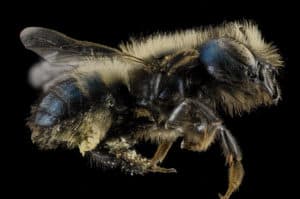This is my second post on the Carolina jessamine plant. The first post covered the effects of Carolina jessamine pollen on Honey bee colonies. The adult bees can become less active and die, and brood can die as well. But the Carolina jessamine plant is native to the Southeast United States. Honey bees are not. They were brought to the Americas by humans. This means that honey bees have not co-evolved with Carolina jessamine the way that native bees have. Do the chemicals in the plant affect native bees as well?
I did a literature search to look for answers to this question. I was able to find studies looking at the effects of a Carolina jessamine alkaloid, gelsemine, on two different native bees: the bumblebee Bombus impatiens and the solitary Megachilid bee Osmia lignaria.

One paper showed that gelsemine generally decreased the proportion of flowers probed and time spent per flower for most floral visitors, including the solitary bee Osmia lignaria (Adler & Irwin 2005). This means they probably don’t like gelsemine very much. Does that mean it is bad for them? Not necessarily. Sometimes we don’t like things that are good for us, and sometimes we like things that are bad for us.
Another paper showed that feeding Osmia lignaria large amounts of gelsemine did not affect their offspring performance. This means that when adult bees were fed a lot of the alkaloid gelsemine, their eggs/young still took the same amount of time to develop and weighed the same amount as the eggs/young of bees that were not fed gelsemine (Elliot et al. 2008). Does this mean that gelsemine does not harm Osmia lignaria? Well, not necessarily. But all of those measures are important indicators of fitness. It shows that, immediately after eating the chemical, the bees are able to have seemingly normal, healthy offspring. I find it interesting that these bees avoid food containing the gelsemine alkaloid even though it does not affect their offspring performance.

So what about bumblebees? A study from the Manson lab at the University of Toronto found that feeding bumblebees gelsemine reduced the size of their eggs, but only for the subordinate bumble bees. It did not significantly affect dominant (queen) bees (Manson et al. 2009). Why? It might just be because the subordinates are smaller, so the chemical could affect them more than it would a larger, dominant bee.
In another study from the Manson lab, researchers fed gelsemine-laced nectar to the same species of bumblebee, but these bumblebees had had been infected with a common bumblebee gut parasite, the protozoan Crithidia bombi. They found that the gelsemine actually reduced the intensity of the infection in the bumblebees after 7 days. This difference was not as dramatic (i.e. was not statistically significant) after 10 days, so we don’t know how much this could realistically help infected bumbles living in the wild, but the researchers think that infected bees could potentially seek out Carolina jessamine for medicinal purposes (Manson et al. 2010). Do they? We don’t know.
At this point, you may be wondering, what does this all mean? Does Carolina jessamine harm native bees?
Mostly, we don’t know.
But here is what we do know:
One main chemical found in Carolina jasmine pollen does not seem to affect offspring performance of Osmia lignaria, but it does have some negative effects on Bombus impatiens. (We don’t have information on how it affects other native bees.)
The same chemical seems to reduce the intensity of Crithidia bombi, a common pathogen of bumblebees, in the bumblebee gut. It is possible that eating some of the chemical could help a bee infected with this pathogen survive.
Native bees are less likely to be negatively affected by Carolina jessamine than honey bees, because native bees and Caroline jessamine are both native to the US, and have had time to co-evolve.
Am I suggesting we eradicate Carolina jessamine?
Nope! I just thought these studies were interesting.
Cited Papers
Adler, Lynn S., and Rebecca E. Irwin. “Ecological costs and benefits of defenses in nectar.” Ecology 86.11 (2005): 2968-2978.
Elliott, Susan E., et al. “The nectar alkaloid, gelsemine, does not affect offspring performance of a native solitary bee, Osmia lignaria (Megachilidae).” Ecological Entomology 33.2 (2008): 298-304.
Manson, Jessamyn S., Michael C. Otterstatter, and James D. Thomson. “Consumption of a nectar alkaloid reduces pathogen load in bumble bees.” Oecologia 162.1 (2010): 81-89.
Manson, Jessamyn S., and James D. Thomson. “Post‐ingestive effects of nectar alkaloids depend on dominance status of bumblebees.” Ecological Entomology 34.4 (2009): 421-426.